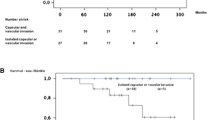Abstract
Infiltration of the capsule, vascular invasion, and/or neoplastic extension into the adjacent parenchyma are regarded as prerequisites for the diagnosis of follicular carcinoma. In modern practice, most of these tumors fall into the category of follicular carcinoma, minimally invasive (FCMI) characterized by evidence of limited capsular or vascular invasion with an excellent long-term prognosis and a good patient outcome. Notwithstanding the wide acceptance of the diagnostic criteria established by the World Health Organization for the classification of follicular carcinomas in particular, they have been difficult to apply and have led to a great deal of confusion. This confusion is compounded when applied to “low-grade” or “minimally invasive” follicular carcinoma because of the poor reproducibility of the classification and the variable results reported in the literature. Our surgical colleagues face a similar lack of a standardized treatment for low-grade follicular carcinomas, which leads to unnecessary surgical treatment. Standardization of histologic criteria is necessary to promote confidence and uniformity in the therapeutic approach of these tumors. We believe that a FCMI is defined as an encapsulated follicular tumor (not papillary), with only small to medium vessel invasion within or immediately adjacent to the tumor capsule and/or up to full-thickness capsular transgression without accompanying extension into the thyroid parenchyma with intervening fibrosis. By using these criteria, patients can be managed with conservative surgical excision to yield an excellent long-term patient outcome.
Similar content being viewed by others
References
Hedinger CE, Williams ED, Sobin LH, eds. Histological typing of thyroid tumors. 2nd ed. Heidelberg: Springer-Verlag, 1988.
Rosai J, Carcangiu ML, DeLellis RA. Follicular carcinoma. In: Rosai J, Carcangiu ML, DeLellis RA, eds. Tumors of the thyroid gland. 3rd series. Washington, DC: Armed Forces Institute of Pathology. 49–64,1992.
Thompson LDR, Wieneke JA, Paal E, Frommelt RA, Adair CF, Heffess CS. A clinicopathologic study of minimally invasive follicular carcinoma of the thyroid gland with a review of the English literature. Cancer 91:505–524, 2001.
Kahn NF, Perzin KH. Follicular carcinoma of the thyroid: an evaluation of the histologic criteria used for diagnosis. Pathol Ann 18(Pt. 1):221–253, 1983.
Fransilla KO, Ackerman LV, Brown CL, Hedinger CE. Follicular carcinoma. Sem in Diagn Pathol 2:101–122, 1985.
Yamashina M. Follicular neoplasms of the thyroid: total circumferential evaluation of the thyroid capsule. Am J Surg Pathol 16:392–400, 1992.
Lang W, Georgii A, Stauch G, Kiensle F. The differentiation of atypical adenomas and encapsulated follicular carcinomas in the thyroid gland. Virch Arch Pathol Anat Histol 385:125–141, 1980.
Guilliland FD, Hunt WC, Morris DM, Key CR. Prognostic factors for thyroid carcinoma: a population-based study of 15,698 cases for Surveillance, Epidemiology and End results (SEER) program, 1973–1991. Cancer 79:564–573, 1997.
Lerch H, Schober O, Kuwet T, Saur HB. Survival of differentiated thyroid carcinoma studied in 500 patients. J Clin Oncol 15:2067–2075, 1997.
Gemsenjäger E, Heitz PU, Martina B. Selective treatment of differentiated thyroid carcinoma. World J Surg 21:546–552, 1997.
Arganini M, Behar R, Wu T-C, Straus F II, McCormick M, DeGroot LJ, Kaplan EL. Hürthle cell tumors: a 25-year experience. Surgery 100:1108–1115, 1986.
Emerick GT, Duh QY, Siperstein AE, Burrow GN, Clark OH. Diagnosis, treatment, and outcome of follicular thyroid carcinoma. Cancer 72:287–295, 1993.
Torre G, Borgonovo G, Amato A, Arezzo A, De Negri A, Mattiolo FP. Differentiated thyroid cancer: surgical treatment of 190 patients. Eur J Surg Oncol 22:276–281, 1996.
Sanders LE, Silverman M. Follicular and Hürthle cell carcinoma: predicting outcome and directing therapy. Surgery 124:967–974, 1998.
DeGroot LJ, Kaplan EL, Shukla MS, Salti G, Straus FH. Morbidity and mortality in follicular thyroid cancer. J Clin Endocrinol Metab 80:2946–2953, 1995.
Author information
Authors and Affiliations
Corresponding author
Rights and permissions
About this article
Cite this article
Heffess, C.S., Thompson, L.D.R. Minimally invasive follicular thyroid carcinoma. Endocr Pathol 12, 417–422 (2001). https://doi.org/10.1385/EP:12:4:417
Issue Date:
DOI: https://doi.org/10.1385/EP:12:4:417




